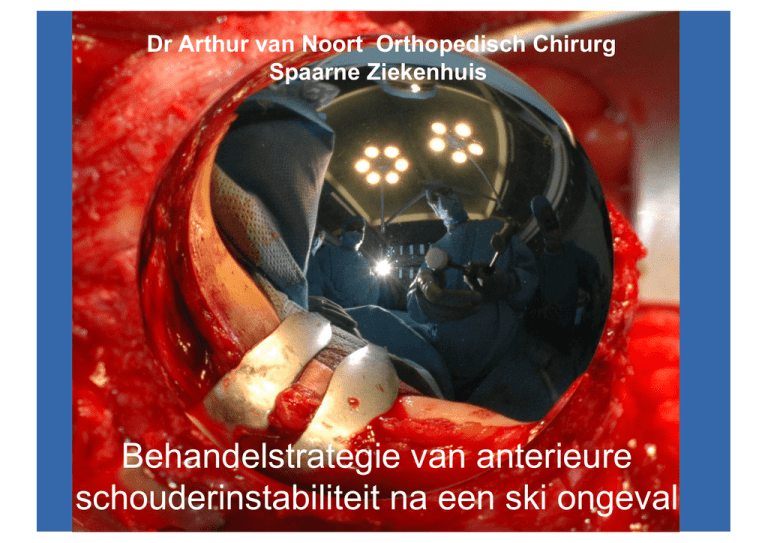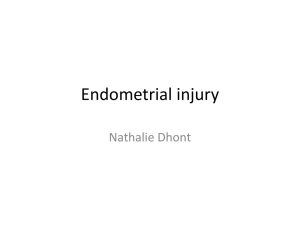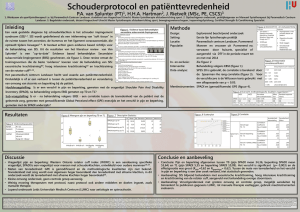Postolympisch congres van Noort kopie
advertisement

Dr Arthur van Noort Orthopedisch Chirurg Spaarne Ziekenhuis Behandelstrategie van anterieure schouderinstabiliteit na een ski ongeval Disclosure information I disclose the following financial relationships with commercial entities that produce health-care related products or services: Consultant for: DePuy Synthes INTRODUCTIE • • • • • H SOCHI 2014: Anterieure schouderluxaties ? Epidemiologie Klassieke beeld of uitgebreider letsel Behandelstrategie (glenoid/humeruskop) Conclusies/Aanbevelingen Aantal geblesseerde atleten in Sochi is te vergelijkbaar met vorige Spelen. (IOC) Ondanks verschillende zware valpartijen in het Rosa Khutor Extreme Park. De afgelopen dagen liepen enkele atleten zware blesssures op, voornamelijk bij het freestyleskiën en het snowboarden. KRASNAYA POLYANA, Russia – American snowboarder Arielle Gold will not compete in the Olympics after suffering an unspecified shoulder injury in training on Wednesday. Skier Marie-Michele Gagnon dislocates shoulder, plans to race slalom “There’s no fracture,” Ansermoz said. “No nerve damage. She’s a fighter. She has a second chance at the Olympics, and she’s going to take the chance.” KLASSIEK LETSEL: LABRUM LESIE MET PLASTISCHE DEFORMATIE VAN LIGAMENTAIR COMPLEX ? Benige Bankart lesie EPIDEMIOLOGIE • Meest voorkomend luxerend gewricht (≈ 50%) • 95.8% van de glenohumerale luxaties van H type het anterieure type en 4.2% overige = gelijke verdeling algemene populatie. • Letsels bovenste extremiteit: snowboarders > skiërs • 5.5% van alle letsels en 71% van alle luxaties • 0.0676 per 1000 “participant days” in snowboarders en 0.0295 per 1000 “participant days” in skiërs . (Luxatie kans ≅ alg populatie/jaar) • Factoren: leeftijd; geslacht; ervaring; snelheid; sneeuwconditie. • Ernstig (geassocieerde) letsels (botverlies glenoid/luxatie fracturen) Ogawa H, Sumi H, Sumi Y, et al. Glenohumeral dislocations in snowboarding and skiing. Injury 2011; 42: 1241-1247 BEHANDELSTRATEGIE De vraag is: wat is de correcte behandelstrategie H Prof. Pascal Boileau Dr Ron te Slaa BEHANDELSTRATEGIE De juiste Operatie voor de juiste patient H Arthroscopische Bankart Repair Level 3 (Case Control) • Cohort 131 pat. Follow up 32 maanden. Geen pat. Selectie • 15% recidief RISICOFACTOREN ??? 75% recidief glenoid botverlies + hyperlaxiteit Boileau P et al. Risk Factors for Recurrence of Shoulder Instability After Arthroscopic Bankart Repair Shoulder Instability After Arthroscopic Bankart Repair JBJS (Br) 88-A 2006; 8: 1755-1463 BEHANDELSTRATEGIE: Instability Severity Index Score (ISIS) prognostische factoren punten < 20 jaar: 31%≤ 20recidief >30 jaar:2 4% punten leeftijd op moment van de operatie > 20 competitief H recreatief/geen sport contact-/bovenhandse sport overige sport zichtbaar op exorotatieopname niet zichtbaar op exorotatieopname verlies van contour normale contour Competitief: 50% recidief niveau sportparticipatie type sport Contact sports: 33% recidief Hill-Sachs-laesie op AP-röntgenopname Hyperlaxiteit: 19% recidief botverlies glenoïd op AP-röntgenopname 0 2 0 1 0 2 0 2 0 Totale puntenaantal: Hills Sachs bij exo opname: 31% Bij een ISIS boven de 5 punten is volgens Boileau een artroscopische stabilisatie gecontra-indiceerd. Glenoid subst verlies: 37 % (11%) Tabel 1. Instability severity index score (ISIS). Balg F, Boileau The instability severity index score. JBJS (Br) 89-B 2007; 11: 1470-1477 Resultaten van operatieve behandeling Lenters e.a. beschrijven in een recente meta-analy- diteit in vergelijking met een open techniek.64-66 Dit betreft overigens specifiek de patiëntengroep THE INSTABILITY SEVERITY INDEX SCORE Hyperlaxiteit 1471 ographics Number (%) 103 (78.6) 28 (21.4) Anterieur: Exorotatie >90° 73 (55.7) 58 (44.3) 82 (62.6) 49 (37.4) 27.3 (14 to 62) Inferieur: 1472 34 (26.0) 48 (36.6) 49 (37.4) F. BALG, P. BOILEAU Fig. 1 External rotation of more than 85˚ with the arm at the side demonstrates anterior shoulder hyperlaxity. 17.9 (2 to 200) 2.6 (0 to 40) 15.2 (0 to 20) 110 (84.0) 21 (16.0) 110 (84.0) 21 (16.0) 30 (22.9) 86 (65.6) 15 (11.5) months’ follow-up. Exclusion criteria were: patients with a concomitant rotator cuff lesion (7) or an acute first-time dislocation (3); surgery for recurrent instability after a previous anterior stabilisation (14); surgery for a painful, unstable shoulder without true dislocation or subluxation (18), and multidirectional instability. No patient was excluded for bone loss, high-risk sports and activities or Hyperabductie > 20° on and Exclusion Criteria rder to evaluate the value of this arthroscopic Bankart edure, we decided to perform this operation only in a f consecutive patients with traumatic, recurrent anterior ity, regardless of the preoperatively identified lesions. teria for inclusion were (1) the presence of traumatic, reanteroinferior shoulder instability, (2) labral repair and retensioning with use of a single arthroscopic technique ture anchors, (3) surgery performed by the senior surP.B.) or under his direction, and (4) a clinical examinad interview with the patient performed at least two years rgery by independent observers. xclusion criteria were (1) arthroscopic stabilization for first) anterior dislocation or subluxation; (2) arthrostabilization after a previous failed instability repair; (3) preference for open stabilization; (4) other types of ity such as voluntary instability, posterior instability, ultidirectional instability (defined as instability in three ons)24. etween July 1999 and August 2001, 100 consecutive s who had arthroscopic Bankart repairs for traumatic, nt anterior shoulder instability, with use of suture anFig. 4a met the inclusion criteria. strated anterior hyperlaxity. Inferior shoulder laxity was defined as a difference of INSTABILITY SEVERITY INDEX SCORE >20° THE between sides on hyperabduction (the Gagey test)28,29. This sign is usually unilateral and is an indicator of a stretched inferior capsule because of plastic deformation of the inferior glenohumeral ligament secondary to instability29. Twenty-six patients demonstrated such inferior laxity. Sixteen patients were considered to have a stretched inferior glenohumeral ligament. Evaluation of Osseous Lesions and Bone Loss All patients underwent a preoperative radiographic evaluation, including anteroposterior radiographs made with the arm in three different rotations (neutral, external, and internal), a scapular lateral radiograph, and an axillary radiograph. Assuming that bone loss was a risk factor for the recurrence of instability, we asked our patients to have a preoperative computed tomographic scan, unless they already had a magnetic resonance imaging scan. Preoperative computerized tomography scans were available for sixty-six patients. All patients had an arthroscopic examination, with the arthroscope placed first in the posterior portal and then in the anterior portal. Evaluation was initially performed with Fig. 4b to gauge the humeral translause of 20 mL of air insufflation 1473 Fig. 4c Population Glenoid lesions on anteroposterior radiographs showing a) normal shoulders, b) avulsion fracture, and c) loss of inferior contour. atients were lost before two years of follow-up, leaving a of ninety-one patients available at the time of the final Seventy-one patients (78%) were male. The mean age patients was 21.5 ± 3.5 years (range, twelve to forty-nine at the time of injury and 26.4 ± 5.4 (range, seventeen to wo years) at the time of surgery. The dominant side was d in fifty-three patients (58%). Bilateral anterior instavated frompatients the anterior glenoid, was present in fifteen (16%). The diagnosisthe of aim being to shift the Paired Student’s t-tests were used to compare means. A r instability was made when there and was a laterally. history of sublabrum proximally Visualisation of the sub- score was calculated with this information, keeping factors n with spontaneous reduction or a history of disloscapularis fibres and a feeling of elasticity of the inferior with a p-value < 0.05 and those with strong support in the requiring manual reduction, and all patients had a 25,26 thought to indicate satisfacwere literature. The score was then re-applied to the study pop. Twentye anteriorglenohumeral apprehension andligament relocation test tients had recurrent dislocations, thirty-nineThe had aim re- of the procedure was ulation and a stepwise scale with associated recurrence rate tory soft-tissue mobilisation. subluxations, and thirtythe had anterior both subluxations andAfter decorticating the was tested. Analysis was performed using SPSS statistical to retension capsule. tions. The average number of instability episodes varneck,two holes were at the edge of the anterior software version 11.0 (SPSS Inc., Chicago, Illinois). th seven glenoid episodes (range, to forty) forsited the patients slocations, twenty-three episodes A (range, two to 150) for (Spectrum, ConMed articular surface. hooked needle Fig. 1 ients with subluxations, and Florida) twenty episodes (range,to pass Linvatec, Largo, was used a suture (PDS II Results GLENOID SUBSTANTIE VERLIES head with computed tomography scans because a standardized protocol was not used. The term “humeral bone defect” was arbitrarily applied if a clinically “important” part of the humeral head surface was missing on assessment during the arthroscopic procedure. Hills Sachs Lesie Evaluation of Labral and Ligamentous Lesions Arthroscopic examination was used to evaluate the extent of the labral detachment around the glenoid, the degree of capsular laxity, and the quality of the tissue by direct visualization Fig. 2 Labral detachment from the glenoid rim was divided into six zones (A, B, C, D, E, and F). Fig. 2a Fig. 2b A difference in hyperabduction of 20˚ or more between the sides demonstrates inferior shoulder hyperlaxity (i.e. a stretched inferior axillary pouch). Fig. 3-A Fig. 3-B A humeral bone defect (a large Hill-Sachs lesion involving >25% of the articular head surface) can be appreciated on the anteroposterior radiograph made with the shoulder in internal rotation (Fig. 3-A) and during arthroscopy (the arthroscope is posterior) (Fig. 3-B). Downloaded From: http://jbjs.org/ by a Spaarne Ziekenhuis User on 09/19/2013 HILLS SACHS LESIE • Aangezien de meeste Hill-Sachs-laesies klein (0-2 cm) of gemiddeld (2-4 cm) zijn, lijken ze geen invloed te hebben op recidiefinstabiliteit. H • Klinische relevantie ? • Groot defect: mogelijkheid contact hills sachs lesie en glenoid (engaging hills sachs lesie). Groter dan 60% vd radius Fig. CR, 1 Burkhart SS. Use of preoperative three- dimensional Chuang TY, Adams computed tomography to quantify glenoid bone loss in shoulder instability. Arthroscopy. 2008;24:376-82. BEHANDELSTRATEGIE Waarde van ISIS Score “aangetoond” H Validation of the ISIS Score in a multicenter reliability study in 114 consecutive cases Rouleau et al. Am J Sports Med 2013 Can we improve the indication for Bankart arthroscopic repair? A preliminary clinical study using the ISIS score. Thomazeau et al. Orthop Trauma Surg Res 2010 Omslagpunt ? < 5 …< 3 ? BEHANDELSTRATEGIE: de praktijk • Eerste posttraumatische anterieure luxatie bij niet-topsporter volgens de richtlijn: conservatief • Recidief luxatie: persisterende instabiliteit – positieve apprehension/ relocation – ISIS (< 5) – geen substantieverlies op X • Aanvullend MRI arthro: ARTHROSCOPISCHE STABILISATIE Nederlandse Orthopaedische Vereniging. Richtlijn Acute primaire schouderluxatie: diagnostiek en behandeling. Alphen aan den Rijn: Van Zuiden, 2005. BEHANDELSTRATEGIE: de praktijk • Recidief luxatie: persisterende instabiliteit – positieve apprehension/ relocation – ISIS (> 5 ?) – wel substantieverlies op X • Aanvullend 3d CT-wegscannen humeruskop: < of >20% verlies • Voorheen Open Bankart Repair – Tendens richting (open) Latarjet Techniek (congruent arch techniek- Joe de Beer) ig. 2-A ig. 3-A BEHANDELSTRATEGIE: de praktijk • Recidief luxatie: persisterende instabiliteit – positieve apprehension/ relocation – ISIS (> 5 ?) – wel substantieverlies op X van glenoid en humeruskopFig. 2-B • Testen bij scopie: engaging hills sachs ? Engaging Hills Sachs: Latarjet • Alleen substantie verlies humerus Remplissage ? Fig. 3-B 2014, 4(1):e4 Wolf EM et al. Hill-Sachs remolissage: an arthroscopic solution for the 6 engaging Hill-Sachs lesion Arthroscopy 2004; 20:e 14-15 (Suppl) ded From: http://surgicaltechniques.jbjs.org/ by a UVA UNIVERSITEITSBIBLIOTHEEK SZ User on 03/23/2014 BEHANDELSTRATEGIE: de praktijk Porcellini, Solomonsson Evaluation of a treatment algorithm for acute traumatic osseous Bankart lesions resulting from first time dislocation of the shoulder with a two year follow-up. Spiegl et al. BMC Musculoskelet Disord. 2013; 14: 305. Conclusies/aanbevelingen • Skiën: Hoog risico sport mbt voorste schouderluxatie/instabiliteit • Skiërs (snowboarders) meer kans op uitgebreider letsel na een voorste schouderluxatie • Mbt behandelingsstrategie is het van belang de risicofactoren bij het individu te her- en erkennen: leeftijd, type sport, niveau, hyperlaxiteit en substantieverlies van glenoid en humeruskop • Naar mate het aantal risicofactoren afneemt , neemt de voorspelbaarheid op een goede afloop na een arthroscopische stabilisatie toe. Anterieure schouder luxatie persisterende instabiliteit Benig letsel (niet acuut) GLENOID VERSUS HUMERUSKOP Glenoid: >20%: Latarjet <20%: ? LatarjetScopisch Geen Benig letsel (alpsa,hagl,bankart) ISS (<5) X: geen ossale afw Humeruskop: >60% radius: Latarjet <: ?/geen consequenties Arthroscopische stabilisatie Bedankt voor uw aandacht Dank voor uw aandacht

